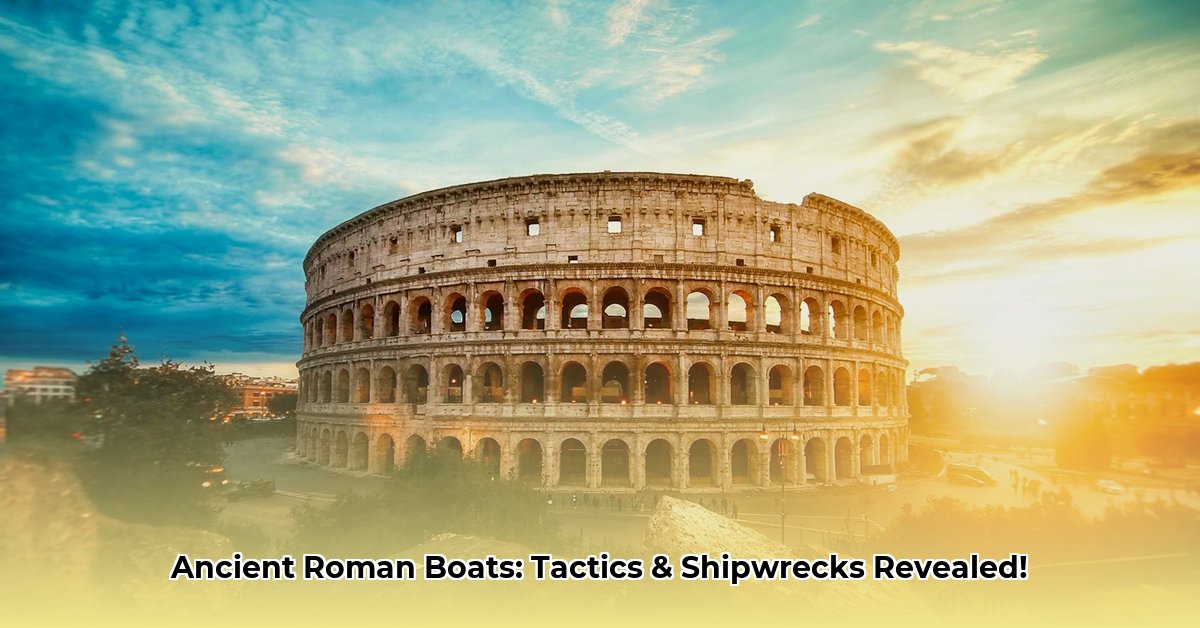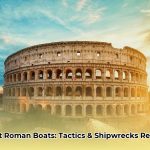The Roman Empire, renowned for its formidable legions and expansive land conquests, extended its dominion far beyond its terrestrial borders. Its true mastery, underpinning centuries of unparalleled growth and sustained control, resided significantly in its sophisticated naval capabilities. Far from being an inherently seafaring people, the Romans meticulously adapted, innovated, and ultimately engineered a maritime force that transformed the vast Mediterranean into their exclusive “Mare Nostrum” – “Our Sea.” This comprehensive exploration delves into the intricate world of Roman naval architecture, ingenious tactical innovations, and the critical maritime infrastructure that served as the lifeblood of their colossal empire. We will navigate through the diverse array of Roman vessels, dissect their revolutionary battle strategies, and uncover how archaeological discoveries continue to illuminate the profound influence of sea power on Roman civilization. You can see examples of ancient Roman ships designs online.
The Genesis of Roman Naval Supremacy: From Adaptation to Innovation
Rome’s initial ventures into naval warfare were born less of inherent expertise and more of strategic necessity. Confronted by the dominant maritime power of Carthage during the First Punic War (264–241 BCE), the Romans, then largely a land-based force, faced an existential challenge at sea. Their pragmatic genius, however, shone through. Rather than reinventing the wheel, they famously reverse-engineered a shipwrecked Carthaginian quinquereme, a powerful warship that served as the blueprint for their burgeoning fleet. This foundational act of reverse engineering marked the decisive beginning of Rome’s ascendancy as a naval power.
Engineering a Fleet: The Art and Science of Roman Shipbuilding
Ancient Roman shipbuilding, unlike modern practices driven by precise engineering, was a blend of inherited techniques, empirical knowledge, and skilled craftsmanship. Early Roman vessels often leveraged the “hull-first” construction method, where the outer planks were meticulously joined before the internal framework was added. This contrasted with later “frame-first” constructions that became prevalent in the first centuries CE, significantly streamlining the building process and shortening construction times. Essential techniques included:
- Material Selection: Robust timbers such as oak, pine, fir, and cedar were carefully chosen for their specific properties. Oak, known for its durability, was often preferred for keels and other structural components, while lighter woods might be used for planking.
- Joinery: Planks were secured using the locked mortise-and-tenon method, providing exceptional structural integrity and seaworthiness. Iron nails were also extensively used for fastenings.
- Sealing: To ensure watertightness, seams and gaps were meticulously caulked with materials like tar, pitch, or natural fibers, a labor-intensive but critical step.
- Lead Sheathing: A testament to their advanced understanding of maritime preservation, lead sheathing was sometimes applied to hulls, particularly for larger merchant vessels, to protect against destructive shipworms and corrosion, significantly extending a vessel’s lifespan.
The scale of Roman shipbuilding was immense. For instance, historians record that during Julius Caesar’s planned invasion of Britain, some 600 oared transport ships were constructed in a single winter, showcasing an astonishing capacity for rapid naval expansion.
Redefining Naval Combat: The Corvus and Boarding Tactics
Initially, Roman naval tactics mirrored those of their Mediterranean predecessors, emphasizing ramming maneuvers. However, their strategic ingenuity quickly led to a revolutionary shift. Recognizing the superior training and discipline of their legionaries, the Romans sought to transform sea battles into land-based engagements. The invention of the corvus (Latin for “raven”) became the pivotal innovation in this endeavor.
The corvus was a hinged boarding bridge, approximately 4 feet (1.2 meters) wide and 36 feet (11 meters) long, with a heavy, pointed iron spike (resembling a raven’s beak) on its underside. When swung down, this spike would pierce and firmly anchor into an enemy ship’s deck, creating a stable gangway for Roman marines to board. This directly countered the Carthaginian advantage in maneuverability and ramming, allowing Roman heavy infantry to close with and capture enemy vessels. While incredibly effective—contributing to five major Roman naval victories in the First Punic War—the corvus also carried a critical flaw: its significant weight, positioned high above the waterline, rendered Roman ships top-heavy and dangerously unseaworthy, especially in rough waters. This vulnerability may have contributed to catastrophic losses in storms, leading to its eventual abandonment after 255 BCE. Agrippa later introduced a similar, though perhaps more refined, weapon called the harpax.
A Fleet for Every Purpose: Diverse Roman Ship Types
The Roman navy comprised a diverse array of vessels, each meticulously designed for specific functions, from powerful warships to indispensable cargo carriers.
Warships (
Naves Longae):- Quinqueremes: Meaning “five-oared” (likely denoting five oarsmen per bank), these were the workhorses of the Roman fleet during the Punic Wars. Approximately 150 feet (45 meters) long, 16 feet (5 meters) wide, and displacing around 100 tons, they carried a crew of 300 (280 oarsmen and 20 deck crew) and up to 120 marines. Their primary role shifted from ramming to facilitating boarding.
- Triremes, Quadriremes, Hexaremes: These galleys, with three, four, and six oarsmen per bank respectively, were also part of the Roman war fleet, though often less prominent than the quinquereme during the Punic Wars. Triremes, traditionally the dominant warship of earlier Mediterranean civilizations, were adopted and adapted by the Romans.
- Liburnae: After the Battle of Actium (31 BCE), the nimble liburna, a compact bireme (two banks of oars) originally used by Illyrian pirates, became the backbone of the imperial Roman navy. Measuring around 109 feet (33 meters) long and 16 feet (5 meters) wide, with a draft of 3 feet (1 meter), they were faster, lighter, and more agile than larger galleys. Capable of 14 knots under sail and over 7 knots under oar power, liburnae were ideal for patrols, raiding, and swift troop transport along rivers and imperial coasts. Over time, “liburna” became a generic term for various Roman ships.
- Navis Lusoria: A small, fast military vessel of the Late Roman Empire, powered by about 30 soldier-oarsmen and an auxiliary sail. These shallow-draft vessels were primarily used on northern rivers like the Rhine and Danube, crucial for border defense. Discovery of actual lusoriae at Mainz in the 1980s provided invaluable insights into their design.
Merchant and Transport Vessels (
Naves Onerariae):- Naves Onerariae (Cargo Ships): These large, sail-driven vessels formed the logistical backbone of the empire. With length-to-breadth ratios of about 3:1 (compared to 6:1 or 7:1 for warships), they were built for maximum cargo capacity rather than speed or maneuverability. Carrying capacities ranged from 70 to 600 tons, with some “monsters” reportedly hauling up to 2,000 tons (the equivalent of 40,000 amphorae). They relied on favorable winds, often sailing with two or three square-rigged masts and a small triangular foresail (the supparum).
- Corbitae: A type of grain ship, dating back to Greek designs, capable of hauling large quantities of grain and liquids (in amphorae). Their hulls were large with high sides, steered by twin steering oars.
- Actuaria and Actuariolum: The actuaria (short for navis actuaria) was a merchant galley equipped with both sails and oars, used where speed and reliability were paramount for transporting passengers, perishables, or even live animals. The actuariolum was its smaller counterpart, serving primarily as a passenger ferry, often unbridged and easily hauled ashore.
- Obelisk Transport Ships: Gigantic, specialized ships constructed to transport massive Egyptian obelisks across the Mediterranean to cities like Rome and Constantinople. Accounts describe intricate loading procedures involving canals and ballasted vessels. Two famous examples, carrying the Vatican obelisk, were later repurposed or destroyed.
- Cercurus: A cargo ship, of Cypriot origin, primarily oar-driven with a large loading space, believed to be one of the earliest merchant galleys.
Smaller and Specialized Craft:
- Cymba: A classic, unbridged wooden fishing boat, propelled by oars and gaff.
- Carabus: A late Neolithic-era boat, essentially a large wicker basket waterproofed with sewn animal skins, used on lakes, rivers, and for calm coastal cabotage.
- Scapha: A very small boat, akin to a yawl, used for dispatch or connecting between larger ships and land.
- Penteconter: An ancient, unrepaired galley with 50 rowers in a single row, used by Romans for liaison, dispatch, rapid transport, or scouting, especially in the early Republic.
Sustaining the Empire: Roman Maritime Infrastructure and Logistics
The true scope of Roman naval power lay not just in its ships, but in the sophisticated network of ports, supply chains, and administrative structures that supported them.
Ports of Power: Gateways to Mare Nostrum
Rome’s strategic control of the Mediterranean was underpinned by a meticulously planned system of naval bases and commercial ports. These hubs were far more than simple docks; they were sophisticated logistical centers providing shelter, repair facilities, and extensive supply depots.
- Misenum: Located near modern Naples, Misenum housed the primary Roman naval fleet (
Classis Misenensis), providing rapid access to the western Mediterranean. It remained the most important naval base throughout imperial times. - Ravenna: Situated on the Adriatic coast, Ravenna was home to the
Classis Ravennas, crucial for safeguarding eastern waterways and projecting Roman power eastward. - Ostia and Portus: Ostia, Rome’s ancient port at the mouth of the Tiber, was the central nexus for all seaborne trade supplying the capital. It was complemented by Portus, an impressive artificial harbor built by Claudius and expanded by Trajan, boasting advanced engineering for its time, including robust docks, vast warehouses, and intricate slipways. These ports handled staggering volumes of cargo; an estimated 1,200 large merchant vessels (around 350 tons each) reached Ostia annually.
- Provincial Fleets: As the empire expanded, specialized provincial fleets were established to patrol rivers and coastlines, including the
Classis Germanica(Rhine),Classis Britannica(English Channel),Classis PannonicaandClassis Moesica(Danube),Classis Syriaca(Syrian coast),Classis Alexandrina(Egypt), andClassis Pontica(Black Sea).
Powering the Fleet: The Human Element of Roman Seafaring
The immense physical demands of synchronized rowing for hours on end raise a perennial question: who comprised the crews of these powerful vessels? Contrary to a persistent popular misconception, Roman rowers were not exclusively slaves. Historical evidence suggests a mixed composition that varied over time and military urgency. Early Republican fleets likely employed Roman citizens and allies, sometimes conscripted. Later, during the Empire, crews often consisted of free men from lower social strata, non-citizens, and even freedmen or slaves, particularly for auxiliary or less prestigious roles. While many rowers were professionals, some might also have been soldiers, especially on patrol vessels where they identified as milites (soldiers) rather than nautae (sailors). Service in the fleet was arduous, typically lasting 26 years, with Roman citizenship often granted upon honorable discharge.
Navigating the Ancient Seas: Skill and Observation
Without modern instruments like compasses or GPS, Roman navigation relied heavily on a blend of practical experience, astute observation, and inherited knowledge, especially from Phoenician and Greek mariners.
- Coastal Navigation (
Periploi): Sailors primarily navigated by keeping land in sight, using recognizable landmarks and detailed written sailing directions (periploi) that charted coastal routes. - Celestial Navigation: In open waters or poor visibility, directions were estimated from the pole star at night and the sun at noon.
- Environmental Cues: Mariners also relied on understanding wind direction, ocean swells, and currents.
- Sounding Leads: Basic tools like sounding leads were used to measure water depth, crucial for approaching coasts or harbors.
Commercial navigation typically suspended during the four winter months (November through March), a period known as the Mare Clausum (“closed sea”), due to unpredictable and dangerous weather conditions. Despite these limitations, Roman ships achieved impressive average speeds of 4-5 knots, with faster trips reaching 6 knots, allowing voyages like Ostia to Alexandria to be completed in 6-8 days under favorable winds.
Echoes from the Deep: The Enduring Legacy of Roman Shipwrecks
Roman shipwrecks are invaluable underwater time capsules, preserving crucial clues about ancient shipbuilding, cargo, trade routes, and the daily lives of sailors. The reasons for their sinking were varied:
- Severe Weather: Sudden, violent storms in the unpredictable Mediterranean were a primary cause of naval losses, claiming entire fleets.
- Naval Combat: Direct engagements, involving ramming, boarding, and missile fire, naturally led to the destruction or crippling of vessels.
- Construction Flaws: Despite Roman engineering prowess, inherent design weaknesses, inadequate maintenance, or issues like wood rot could lead to leaks and eventual sinking. The top-heavy corvus, for example, compromised a ship’s seaworthiness.
- Human Error: Navigation blunders, miscalculations by commanders, or simple accidents contributed to groundings, collisions, and other maritime disasters.
- Logistical Challenges: The immense task of provisioning vast fleets and cities across long distances posed constant logistical hurdles, which could, in rare cases of extreme failure, contribute to vessel abandonment or loss.
Archaeological discoveries of Roman shipwrecks continue to yield profound insights:
- Aegates Islands Rams: Off the coast of Sicily, dozens of bronze Roman and Carthaginian rams, dating to the First Punic War, have been recovered, offering direct evidence of naval combat tactics.
- Nemi Ships: Two elaborate pleasure barges of Emperor Caligula, recovered from Lake Nemi in the 20th century, revealed advanced features like heating and plumbing, showcasing Roman engineering luxury.
- Sinop D (Black Sea): This remarkably well-preserved 5th-century CE merchant vessel, found in the Black Sea’s anoxic depths, has its entire hull, cargo, and even mast intact, providing unprecedented detail on late Roman shipping.
- Mainz Boats (
Navis Lusoria): Discovered near Mainz, Germany, these 4th-century military vessels provide direct evidence of their flat-bottomed, shallow-draft design for riverine patrol. - Madrague de Giens: This large 1st-century BCE merchantman, one of the biggest Roman wrecks excavated (40 meters long, 550 tons displacement), sank off France with a cargo of wine and pottery, offering insights into long-distance trade.
The Roman Empire’s maritime legacy is a testament to its innovation, adaptability, and organizational prowess. From their strategic appropriation of shipbuilding techniques to their ingenious tactical inventions and the establishment of a vast, interconnected maritime infrastructure, the Romans transformed the Mediterranean into an engine of empire. Their mastery of the seas allowed for the transportation of vast quantities of grain, military supplies, and cultural exchange, fueling Rome’s ascent and maintaining its dominant position for centuries. The secrets unveiled by ongoing research into their ships, ports, and submerged relics continue to illuminate the complex interplay of technology, society, and economics that shaped one of history’s most influential civilizations.










